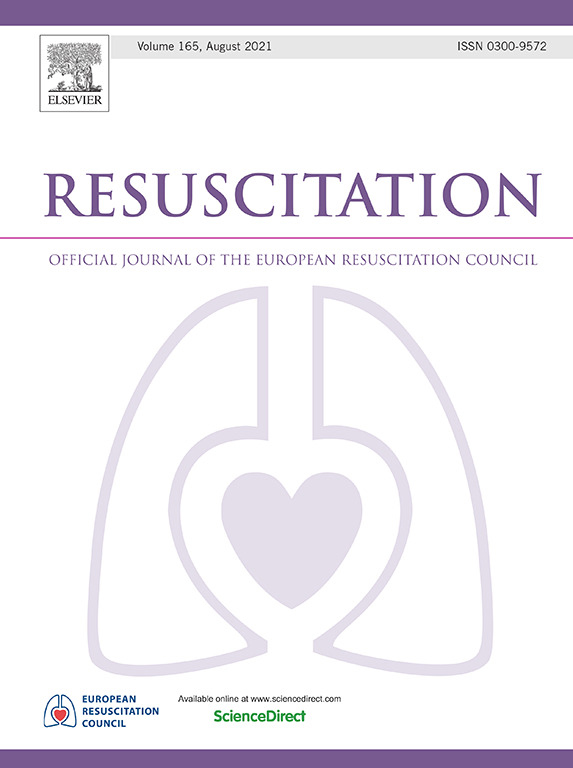Sociodemographic disparities in incidence and survival for pediatric out-of-hospital cardiac arrest in the United States
IF 6.5
1区 医学
Q1 CRITICAL CARE MEDICINE
引用次数: 0
Abstract
Background
Sociodemographic disparities in pediatric out-of-hospital cardiac arrest (OHCA) outcomes exist; differences in pediatric OHCA incidence remain unknown. This study investigated the association between race, ethnicity, and socioeconomic status (SES) with pediatric OHCA incidence and survival. We hypothesized that children who are Black, Hispanic/Latino, or of lower SES would have higher incidence and lower survival rates compared to children who are White or of higher SES.
Methods
This is a retrospective cohort study (2015–2019) of the Cardiac Arrest Registry to Enhance Survival database. We included OHCAs among children < 18 years. The exposures were race, ethnicity, or SES index score. The SES index score incorporated race or ethnicity, household income, high school graduation rates, and unemployment rates on a scale from 0 to 4, with 4 indicating the highest-risk neighborhoods. The primary outcome was incidence (measured per 100,000 children of a particular group). Secondary outcomes included survival to hospital discharge and survival with a favorable neurologic outcome.
Results
Among 6945 OHCAs, 2320 (33.4%) occurred in Black children, 739 (10.6%) in Hispanic/Latino children, 2161 (31.1%) in White children, 188 (2.7%) in children of Other race, and 2855 (41.2%) in highest-risk neighborhoods. Black children had the highest OHCA incidence (15.5) as compared to Hispanic/Latino children (3.3) and White children (3.8), p < 0.001. OHCA incidence was higher in highest-risk neighborhoods (11.6) compared to lowest-risk neighborhoods (4.3), p < 0.001. Black children had lower odds of survival to hospital discharge (adjusted odds ratio [aOR] 0.73, 95% CI 0.59–0.91) and neurologically favorable survival (aOR 0.64, 95% CI 0.50–0.82) compared to White children. Hispanic/Latino children did not have significantly worse survival outcomes compared to White children. Children from the highest-risk neighborhoods had lower odds of survival to hospital discharge (aOR 0.64, 95% CI 0.50–0.81) and neurologically favorable survival (aOR 0.54, 95% CI 0.41–0.71) compared to children from the lowest-risk neighborhoods.
Conclusions
Black children have over four times the OHCA incidence compared to White and Hispanic/Latino children. Children from the highest-risk neighborhoods have more than twice the OHCA incidence compared to children from the lowest-risk neighborhoods. Black children and children from the highest-risk neighborhoods have significantly lower OHCA survival rates.
美国儿童院外心脏骤停发生率和存活率的社会人口差异
儿童院外心脏骤停(OHCA)结局存在社会人口统计学差异;儿童OHCA发病率的差异尚不清楚。本研究调查了种族、民族和社会经济地位(SES)与儿童OHCA发病率和生存率之间的关系。我们假设黑人、西班牙裔/拉丁裔或社会经济地位较低的儿童与白人或社会经济地位较高的儿童相比,发病率更高,存活率更低。方法:这是一项心脏骤停登记处增强生存数据库的回顾性队列研究(2015-2019)。我们在儿童中纳入了ohca;18年。暴露是种族、民族或社会经济地位指数得分。SES指数得分包括种族或民族、家庭收入、高中毕业率和失业率,范围从0到4,其中4表示风险最高的社区。主要结果是发病率(某一特定群体中每10万名儿童测量)。次要结局包括存活至出院和神经系统预后良好的存活。结果6945例ohca中,黑人儿童2320例(33.4%),西班牙裔/拉丁裔儿童739例(10.6%),白人儿童2161例(31.1%),其他种族儿童188例(2.7%),高危社区2855例(41.2%)。黑人儿童的OHCA发病率最高(15.5),而西班牙裔/拉丁裔儿童(3.3)和白人儿童(3.8)。0.001. 高危社区的OHCA发病率(11.6)高于低危社区(4.3),p <;0.001. 与白人儿童相比,黑人儿童存活至出院的几率较低(调整比值比[aOR] 0.73, 95% CI 0.59-0.91),神经系统有利生存率较低(aOR 0.64, 95% CI 0.50-0.82)。与白人儿童相比,西班牙裔/拉丁裔儿童的生存结果并没有明显差。与来自最低风险社区的儿童相比,来自最高风险社区的儿童存活至出院的几率(aOR 0.64, 95% CI 0.50-0.81)和神经系统有利的生存率(aOR 0.54, 95% CI 0.41-0.71)较低。结论:黑人儿童的OHCA发病率是白人和西班牙裔/拉丁裔儿童的四倍多。与来自最低风险社区的儿童相比,来自最高风险社区的儿童的OHCA发病率是其两倍多。黑人儿童和来自高危社区的儿童的OHCA存活率明显较低。
本文章由计算机程序翻译,如有差异,请以英文原文为准。
求助全文
约1分钟内获得全文
求助全文
来源期刊

Resuscitation
医学-急救医学
CiteScore
12.00
自引率
18.50%
发文量
556
审稿时长
21 days
期刊介绍:
Resuscitation is a monthly international and interdisciplinary medical journal. The papers published deal with the aetiology, pathophysiology and prevention of cardiac arrest, resuscitation training, clinical resuscitation, and experimental resuscitation research, although papers relating to animal studies will be published only if they are of exceptional interest and related directly to clinical cardiopulmonary resuscitation. Papers relating to trauma are published occasionally but the majority of these concern traumatic cardiac arrest.
 求助内容:
求助内容: 应助结果提醒方式:
应助结果提醒方式:


